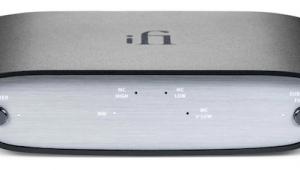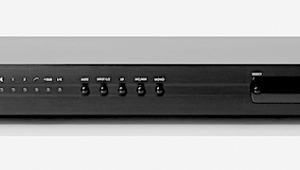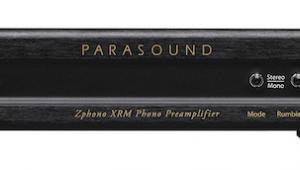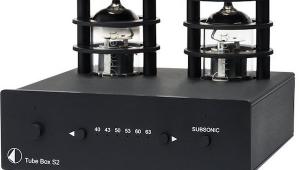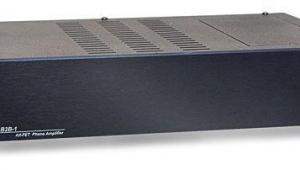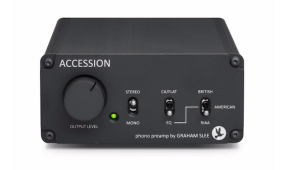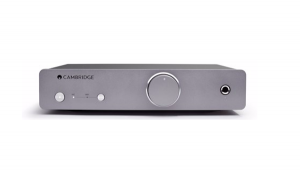Hagerman Audio’s “Tubey” But Quiet Trumpet MC Phono Preamplifier

The JFET input provides variable gain and loading, with split-passive RIAA equalization and 0 feedback throughout. The circuit description says the tube heaters are D.C. and that after a 40 second start up delay, “a highly specialized internal low-noise booster converter generates the B+ and B- rails”. Premium components used throughout include polypropylene capacitors and metal film resistors.
By high performance audio standards, the powdercoated aluminum chassis is thin (the whole thing weighs a mere 3 pounds), but consider that the Trumpet sells for $1099 and provides gain choices of 45dB, 55dB, 60dB, 64dB and 68dB—sufficient for even the lowest output MC cartridges.
Resistive loading choices are 47ohms, 100ohms, 220, 470, 1K and 47K—a sufficient range for most of us. For MM, capacitive loading is 220pF. Other claimed specs are: 10Hz-50kHz bandwidth, 70dBA ref 0.5mV (93dBA ref of full signal) noise, 0.04%@3Vrms distortion, 22Vrms@1% distortion and ±0.5dB RIAA accuracy.
Set-Up
I auditioned the Trumpet MC using both the Ortofon 2M Black 250 LVB and the Ortofon Cadenza Black mounted on the SME Model 6 turntable I reviewed in Stereophile.
The rear panel features chassis mounted gold plated RCA input and output jacks, a ground lug and an input pin for the outboard 15VDC “wall-wart” type power supply. Avoid stiff, heavy cables because unless carefully dressed they could displace or flip the lightweight chassis.
The front panel features a pair of “old school” knobs, the left one labeled “load”, the right one “gain”. Neither are marked so you have to read the instructions to know what’s what. A small pushbutton turns the Trumpet on. After an initial delay of a bit less than a minute the internal high voltage supplies turn on and shortly thereafter when both LEDs light yellow, the unit ready to play.
The instructions say “Best operation is to run LOADING as high as possible (clockwise) and GAIN as low as possible (counter-clockwise). MM cartridges will only function properly with LOADING set to 47kHz and gain at 44dB”. There’s a no 44dB setting so Mr. Hagerman means 45dB, or all the way to the left. 47kHz is with the loading knob fully clockwise.
The MC setting instructions are somewhat unusual. Is Mr. Hagerman suggesting running a low output moving coil cartridge loaded at 47kHz? Seems so but that’s clearly not correct so how can that be “best operation”? Hopefully he’ll answer in a comment. Setting gain as low as possible makes sense if you understand what exactly that means. Do you really want to run a .33mV Ortofon Cadenza Black, for instance, at 45dB gain, which is MM gain? I started there, dutifully following instructions but figured I’d try 55dB so I turned the knob one click and got a super-loud D.C. “THUMP” through the speakers that shut down my amplifiers. Be sure to hit the “mute” button before adjusting gain! That warning should have been in the instructions!
In the end Mr. Hagerman proved subjectively correct if objectively not. For whatever reason, 45dB was more than sufficient for the .33mV Cadenza and I was able to run my preamp at -19dB. This made little sense to me but again looking at the output of 22V (@1% distortion) it suddenly did!
Loading the cartridge at an appropriate 100 ohms produced too soft a top end, even though Ortofon recommends <10 ohms and normally a 5 ohm internal impedance cartridge loads at from 50 ohms to maybe a few hundred. Again Mr. Hagerman proved correct: I left the Trumpet MC at 47kHz because anything lower was too soft for my tastes. Still I wonder about this and hopefully the manufacturer’s comments will clarify.
Sounds “Thick and Rich” Yet Pleasingly Transparent Too
I allowed plenty of break-in time before serious listening, though over time the basis sonic signature did not change. Beyond the JFET input the Trumpet MC is a classic tube design that produced a classic tube sound, though it was also commendably quiet even being driven by low output MCs. So what’s “classic” tube sound? Start with a rich, full midrange that worked wonders on some thin, barren modern recordings and also did well with some older ones. Keep in mind though that I auditioned through the full range Wilson XVX loudspeakers that produce 20Hz (non-boomy) bass in my room. More likely the Trumpet MC will be paired with smaller two way bookshelf speakers or modest floor standers, or perhaps smaller planar magnetics like Magnepan 1.7is.
Neil Young’s recently released Young Shakespeare (Reprise 093624889519) referenced in the Ortofon 2M Black LVB 250 review benefited from the Trumpet MC’s rich midrange, producing a fully fleshed out Neil, center stage as my far more costly front end didn’t manage. Neil’s voice was bigger, more present (not as in bright) and more solid, though I think this is the result of a pleasing additive rather than a more accurate presentation of what’s in the grooves.
The remix of John Lennon’s essential first solo album John Lennon/Plastic Ono Band (0602507354541), which purposely adds body and texture to the original thin and somewhat distant original sounded solid and as intended, enriched by a solid kick drum foundation and full, but well controlled Klaus Voormann’s bass lines. This was a sonic presentation you could crank up to high SPLs and fully enjoy, though the lower-midbass was clearly slightly “thickened” and overall transients were slightly softened.
Female voices didn’t fare quite as well, with the added midband “thickness” impeding lightness and flow on recordings that should produce that. I revisited an old test pressing of Joni Mitchell’s Blue (Reprise MS 2308) mastered by Kevin Gray and Steve Hoffman July 5th 2006 at AcousTech Mastering and compared it to an original of the record, which was mastered by Bernie Grundman. Mitchell’s voice on both pressings had a slight but acceptable “chesty” quality when played back on my “big” front end (Mitchell’s voice “soared”), but it became excessive through the Trumpet MC.
On the other hand, the very bottom was solid and punchy, producing kick drums on most records that rocked with plenty of texture.
I think you get the picture: where there’s an acoustic guitar you get bountiful body and less string transient sparkle. Where there are bright cymbal splashes and crackling snare hits in a drum kit you get less transient “crunch” and snare “cracks” but more body and weight to tom hits.
Conclusion
The $1099 Hagerman Audio Trumpet MC offers big, warm “tube sound” in a compact, versatile package that can accommodate any MM or MC cartridge you choose to use it with. It will provide sufficient gain and low noise for even the lowest output cartridges and it will accommodate them all while producing quiet, hum-free backgrounds.
I’d advise pairing it with a lean or “analytical” cartridge and not with one that brings its own warmth to the table.
If you are looking for timbral neutrality and a light overall touch, the Trumpet MC might not be for you, though that depends on where your system’s sound is now and where you wish to take it. I’ve heard many systems thin in the midbass to midrange region where the Trumpet’s added weight and insistence in that area would be a welcomed addition, though that also depends upon the record!
One thing’s clear, if you are looking for an airy, bright top end and snappy “rhythm’n’pacing overall and a phono preamp “for all seasons”, the Trumpet MC is probably not be for you. If you luxuriate in Technicolor timbral riches and indulge in harmonic glorification and are looking to put some sock into your system, you will love this thing. That’s not a value judgement on my part, because I know plenty of listeners who do and as Pope Francis once famously said about another subject in his book, “who am I to judge?”
All products are handcrafted in the USA, come with a 10-year warranty, 30-day trial period, and free shipping world-wide (not including import duties, VAT, or other local taxes). So why take my word for any of this? Listen for yourself!
Specifications
• 47, 100, 220, 470, 1k, 47k ohm input impedance
• 45dB, 55dB, 60dB, 64dB, 68dB gain
• 220pF loading
• 10Hz to 50kHz bandwidth (-3dB)
• 70dBA ref 0.5mV signal-to-noise
• 0.04% @ 3Vrms distortion (1kHz)
• 22Vrms @ 1% overload (1kHz)
• +/-0.5dB equalization
• 12AX7 x 4, 12AU7 x 2
• 6 x 10 x 3.5 inches
• 3 pounds
• 15Vdc @ 2.05A
• 120V/240V operation
• Includes power supply & tubes
• Free shipping!




